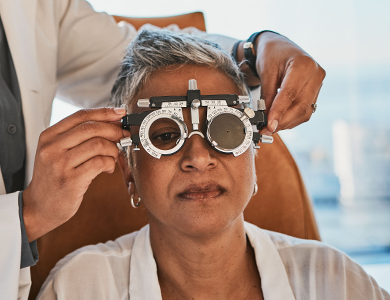
Living with low vision can significantly impact daily tasks like reading, writing, and recognizing faces. Fortunately, specialized optical aids can help maximize remaining vision. Two of the most commonly prescribed tools for near tasks are prismatic glasses and reading telescopes. But how do these devices differ, and which one is right for you?
Understanding Low Vision
Low vision is a term used when someone experiences significant visual impairment that cannot be fully corrected with standard glasses, contact lenses, surgery, or medication. It can be caused by a range of eye conditions, including macular degeneration, diabetic retinopathy, glaucoma, or retinitis pigmentosa. For people with low vision, specialized visual aids like prismatic glasses and reading telescopes can make a meaningful difference in quality of life.
What Are Prismatic Glasses?
Prismatic Glasses use high-powered lenses combined with prism segments to bend light and assist with near tasks like reading or using a smartphone. The prism helps bring the image into a more usable visual field, often making reading more comfortable for those with central vision loss.
Key Benefits:
• Lightweight and cosmetically similar to regular glasses
• Ideal for hands-free reading
• Typically prescribed for individuals who read short amounts of text at a time
• Can be used with both eyes simultaneously, allowing for binocular vision
Considerations:
• Best for individuals who can still see larger print or use magnification
• May not be effective for very detailed tasks or very small print
What Are Reading Telescopes?
Reading Telescopes, or Bi-Optic Telescopes, are miniature telescopes mounted into eyeglasses that magnify near or far objects. These devices allow users to see small print or perform tasks requiring fine detail, such as reading medication labels or doing crafts.
Key Benefits:
• Strong magnification for high-detail tasks
• Customizable for reading distance
• Can be mounted in various positions depending on usage
Considerations:
• May require some training or adaptation
• Heavier than standard lenses
• May provide a smaller field of view than prismatic lenses
Which One Is Right for You?
The choice between prismatic glasses and reading telescopes depends on your specific visual needs, daily tasks, and the severity of your vision loss.
• If you need help with short-term reading or viewing larger print comfortably, prismatic glasses may be a good fit.
• If you require greater magnification for more detailed reading or specific tasks, reading telescopes could offer the enhanced clarity you need.
A comprehensive low vision evaluation is the best way to determine which device—or combination of devices—will best suit your lifestyle. Dr. John P. Jacobi can assess your remaining vision, discuss your goals, and help fit the right optical solution for you.
Ready to See What’s Possible?
Both prismatic glasses and reading telescopes offer unique advantages for individuals living with low vision. The right solution will depend on your personal vision challenges, goals, and how you plan to use the device in your day-to-day life. Rather than navigating the decision alone, working with our low vision specialist can help you regain independence and confidence.
At Beyond Low Vision, we specialize in custom solutions for your visual needs. Visit our office in Novi, Michigan, or call (248) 731-9393 to schedule a low vision consultation and let us help you find the right tools to make everyday life more accessible.





